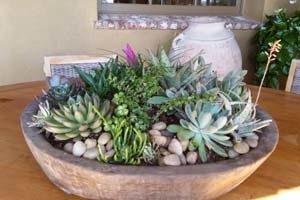
Succulent arrangements create interesting & beautiful focal points in interiorscapes
The succulent trend can hardly be called a trend any longer – these desert natives are making a permanent statement in interiorscapes. We love succulents because they’re low maintenance, beautiful and they thrive in any number of decorative containers. Succulent varieties span the color spectrum from sage green to silvery blue and dusty pink to deep purple. It’s no wonder why they’re so popular!
Succulent facts
Succulents are found in arid climates with strong sunlight, little water and porous soil. They are perfectly suited to survive in this environment because they store water in their thick leaves (some varieties store water in their stems and roots) and have the capacity to pull moisture from the air to survive. In fact, porous soil is necessary for their survival because even with minimal watering, a succulent can grow rotted roots. When adding succulents to any interiorscape, it’s important to approximate these native conditions so your plants have the best chance to thrive. Some varieties that do wonderfully indoors are Haworthia, Kalanchoe, Senecio and Aloe vera.
Succulents are slow-growing and do not grow deep roots. They can be planted in containers of all sizes and depths – from 4″ to 16 gallon planters. For this reason, succulents like hens and chicks, make great additions to beautiful terrariums which are often shallow and have little soil to grow in. You see, succulents do not have many constraints like most plants in your care. Because most varieties are noninvasive, they can be grouped together in small containers creating interesting and decorative focal points that add beauty to any interiorscape. Adding succulent arrangements to your accounts gives you the freedom to be as creative as you want!
Proper care
There’s a misconception that indoor succulents do not need a lot of light. How did that happen? Indoor succulents need 2-3 hours of direct sunlight everyday and it’s best to place them 2-3′ from a sunny window. In fact, a succulent that isn’t getting enough sunlight will grow and stretch towards the sun. This is an indication that your plant needs access to more light during the day. Take note, some varieties like Sedum burrito, string-of-pearls and Aloe vera require filtered sunlight and can become sunburned with too much light. It’s important to understand a plant’s sunlight needs before you place them near a bright window.
Succulents are arid plants and do best with little watering, but it’s also important to remember that even a small amount of water has the potential to cause their roots to rot. To take the guesswork out of watering, test the soil moisture levels with a moisture meter. The soil should be very dry before you add water again. Add enough water just to moisten the soil. Too much water can cause the plant roots to become soggy. The soil composition is also important for succulent care. The mixture should be porous, much like the media they would have in the wild. A succulent potting soil containing perlite, pumice or crushed granite is the best choice for your plants. This soil composition allows for optimal drainage and prevents the roots from sitting in a moist media. In fact, adding more drainage to your succulent containers is your best bet. You can do this by placing small rocks over the container drainage hole and adding the soil mixture on top of that. As you can see, overwatering is something you need to be very mindful of when caring for succulents.
To recap, succulents require less care and maintenance than most plants because of their unique qualities. Maybe we love succulents so much because they are minimalist beauties that can be grouped together in any number of lovely combinations and in nearly any decorative container. Minimal constraint means maximum creativity when creating these gorgeous indoor plantscapes!
